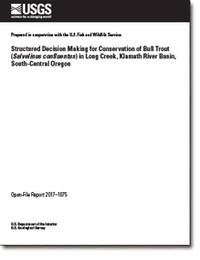Structured decision making for conservation of bull trout (Salvelinus confluentus) in Long Creek, Klamath River Basin, south-central Oregon
Links
- Document: Report (2.6 MB pdf)
- Download citation as: RIS | Dublin Core
Abstract
With the decline of bull trout (Salvelinus confluentus), managers face multiple, and sometimes contradictory, management alternatives for species recovery. Moreover, effective decision-making involves all stakeholders influenced by the decisions (such as Tribal, State, Federal, private, and non-governmental organizations) because they represent diverse objectives, jurisdictions, policy mandates, and opinions of the best management strategy. The process of structured decision making is explicitly designed to address these elements of the decision making process. Here we report on an application of structured decision making to a population of bull trout believed threatened by high densities of nonnative brook trout (S. fontinalis) and habitat fragmentation in Long Creek, a tributary to the Sycan River in the Klamath River Basin, south-central Oregon. This involved engaging stakeholders to identify (1) their fundamental objectives for the conservation of bull trout, (2) feasible management alternatives to achieve their objectives, and (3) biological information and assumptions to incorporate in a decision model. Model simulations suggested an overarching theme among the top decision alternatives, which was a need to simultaneously control brook trout and ensure that the migratory tactic of bull trout can be expressed. More specifically, the optimal management decision, based on the estimated adult abundance at year 10, was to combine the eradication of brook trout from Long Creek with improvement of downstream conditions (for example, connectivity or habitat conditions). Other top decisions included these actions independently, as well as electrofishing removal of brook trout. In contrast, translocating bull trout to a different stream or installing a barrier to prevent upstream spread of brook trout had minimal or negative effects on the bull trout population. Moreover, sensitivity analyses suggested that these actions were consistently identified as optimal across a large range of parameter values. Taken together, these results support the conclusion that management actions focused on controlling brook trout and enhancing migrant bull trout are more likely to yield more adult bull trout within the 10-year time frame specified by stakeholders.
Suggested Citation
Benjamin, J.R., McDonnell, Kevin, Dunham, J.B., Brignon, W.R., and Peterson, J.T., 2017, Structured decision making for conservation of bull trout (Salvelinus confluentus) in Long Creek, Klamath River Basin, south-central Oregon: U.S. Geological Survey Open-Report 2017–1075, 32 p., https://doi.org/10.3133/ofr20171075.
ISSN: 2331-1258 (online)
Study Area
Table of Contents
- Abstract
- Introduction
- Study Area
- Methods
- Model Overview
- Results
- Discussion
- Acknowledgments
- References Cited
| Publication type | Report |
|---|---|
| Publication Subtype | USGS Numbered Series |
| Title | Structured decision making for conservation of bull trout (Salvelinus confluentus) in Long Creek, Klamath River Basin, south-central Oregon |
| Series title | Open-File Report |
| Series number | 2017-1075 |
| DOI | 10.3133/ofr20171075 |
| Publication Date | June 21, 2017 |
| Year Published | 2017 |
| Language | English |
| Publisher | U.S. Geological Survey |
| Publisher location | Reston, VA |
| Contributing office(s) | Forest and Rangeland Ecosystem Science Center |
| Description | iv, 32 p. |
| Country | United States |
| State | Oregon |
| Other Geospatial | Long Creek |
| Online Only (Y/N) | Y |


